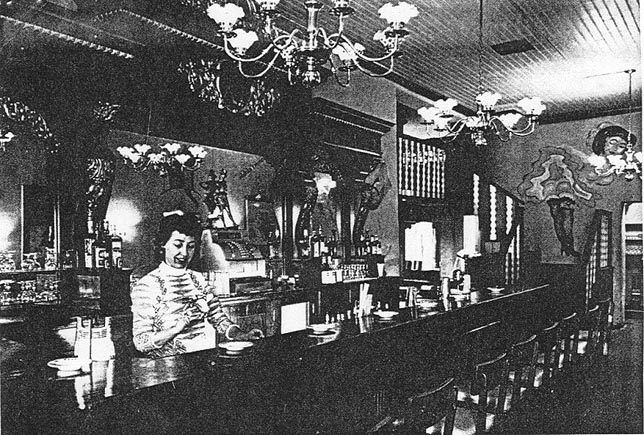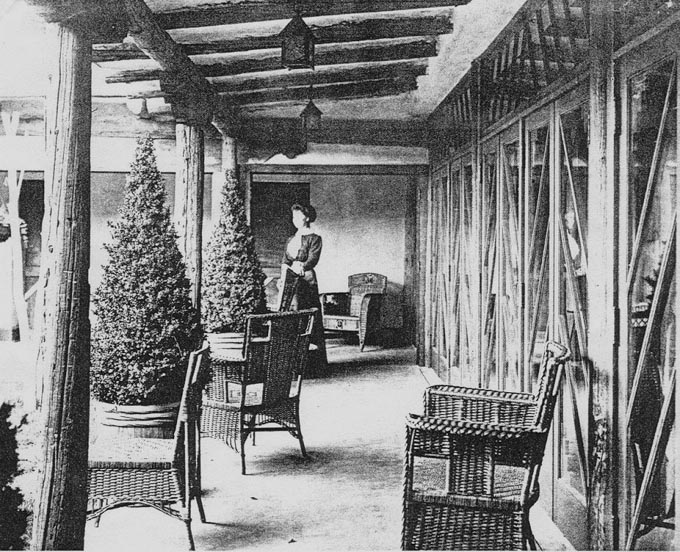Lamy Railroad Junction
by Dudley M. Lynch
 |
 |
 |
The environment is one you might read about in a Conrad Richter novel or see in a Peter Hurd painting: A drowsy dog suns by quaint railroad station...nearly deserted street stretches out behind...weathered signs in big block letters front saloon and general store...ponies graze on stippled hill...tumbleweed nuzzles loaded dock in foreground. The whole is wrapped, on a summer day, in an azure sky with maybe the faintest wisp of a cloud over Placer Mountain to the west.
This is Lamy, population: 75 - located on a dead-end spur off U.S. Hwy. 285 southeast of Santa Fe - where, day in and day out, the most exciting thing that occurs is the passage and brief stops of the Santa Fe Railroad's passenger and freight trains. With arrival of four passenger trains each day, a flurry of activity jerks the small stucco depot to life, but soon the bustle peaks and the aura of tranquility descends again.
Lamy came into being shortly after the railroad pushed deep into New Mexico in 1879. That the railroad was surveyed to run through Glorieta Pass and across the plains toward Albuquerque an not to Santa Fe was a bitter disappointment to Santa Fe citizens. Because of topographical barriers, it was not to be. Once convinced (it required an independent survey paid for by the railroad to do it) that the route would have to go to the southeast. Santa Fe nabobs moved apace to assure the town a connection to the main line. Willing to foot part of the bill, they called a bond election on two issues of $79,000 and $71,000. The vote was 191-72 and 192-67 in favor of the expenditures. "An election never took place in Santa Fe which was so one-sided," exulted a happy newspaper editor. The spur was quickly built (the first train pulled into Santa Fe on February 16, 1880), and where it joined the main line, a town was born.
Through historical sources are vague about the community's early years, it is known that Lamy had a postmaster by March 1, 1881. And because of its proximity to Glorieta Pass, it was destined to grow quickly under the influence of railroad payrolls. To get trains over the pass, a climb of 2,000 feet in about 10 miles was necessary, and extra engines had to be attached. Lamy was the logical location for crews and maintenance facilities. When C.C. Robinson, the present Lamy station agent, worked there for the first time in 1931, five or six engines of the 800 and 900 locomotive classes were kept in reserve. Two or three would be added to the normal complement of engines on each train. The 10-mile trip consumed about an hour. As one former Lamy resident remembers it, the scene was one of "smoke, cinder, steam and gusto!" At the top of the grade, the Lamy locomotives would turn around on a "Y" and come home.
An attraction of early 20th Century Lamy was El Ortiz, a Fred Harvey restaurant and hotel built to accommodate tired and hungry passengers. The hacienda-styled El Ortiz sat just to the east of the present depot and was a gray-stuccoed building that had heavy protruding vigas. Inside, the walls and ceilings were plastered in immaculate white. Santos, Spanish engravings, photographs and old paintings on cow hides decorated the walls of an expansive living room. Indian rugs covered the floors. A huge fireplace had hammered copperwork on its mantle. The dark, dignified, handcarved furniture was formed of brass, leather and Flemish oak. At one end of the room, a wide arch opened the way to the lunchroom. Behind polished counters, the famed Harvey Girls, neat, well-starched in their black-and-white uniforms and unfailingly polite, awaited amid a battery of coffee urns and tea samovars. The El Ortiz' dozen or so hotel rooms - all without baths - opened onto a grassy patio, whose perimeter in the growing season was a verdant scene of hanging vines and split-log planter boxes. El Ortiz was closed in April of 1942, prompting one writer in Santa Fe to note that many would mourn the passing of "the littlest hotel in the littlest town." The building was torn down a few years later.
Lamy was at its peak in the 30s. The census of that decade gave the community a population of 329. The school was a going concern, with about 70 students in the grades one through eight. In 1934, one of the teachers was E.J. Martinez, who is now postmaster of Santa Fe. Martinez remembers, more than anyone else, the musical talents of the youngsters, most of whom came from railroad families. "We never had any trouble putting on a program," he recalls. "Those kids could play the guitar, sometimes the violin and the mandolin. They could play anything without written music."
Another memory of Lamy held by numerous Santa Fe residents is of a casual outing to the little village during those pre-war years. "It was a social event," says a prominent matron, "to drive to Lamy for a cup of coffee."
Today, the site of El Ortiz is a grassy plot with a boscage of big-boughed trees. Down the tracks, the school sits boarded up. Nearby, an American flag flutters from a makeshift pole at the U.S. Post Office branch. The Catholic church - with its silver-painted bell sitting in a windswept loft 28 creaky steps above the landing - shares main street with the depot, the temporarily closed Lamy General Store and the Pink Garder Saloon. The latter, a picturesque place with a huge, German-made cherry wood bear and true-to-saloon-tradition cancan stage, is present-day Lamy's No. 2 drawing card. But since the advent of diesel locomotives, which refuel less and require no help in getting over the mountains, Lamy has declined. The many railroad crews are largely gone, along with most of the numerous shops and barns. The passenger depot is still a busy place, since the station is the terminus for passengers to Santa Fe and Los Alamos. But these days, Lamy is the perfect place for a shaggy yellow dog, a traveler seeking quaint, out-of-the-way places, or for anyone hungering for a few moments of peace and quiet.
New Mexico, October, 1966
 |
 |
Proprietor Billie Trinkle behind the
old-time cherry wood bar in the Pink Garder Saloon. |
The little dining room of the Lamy Fred Harvey House
. |
 |
 |
El Ortiz was one of Fred Harvey's early
efforts at promoting Southwestern style architecture and decor. |
A Harvey Girl of the 1920's on the patio of El Ortiz. |